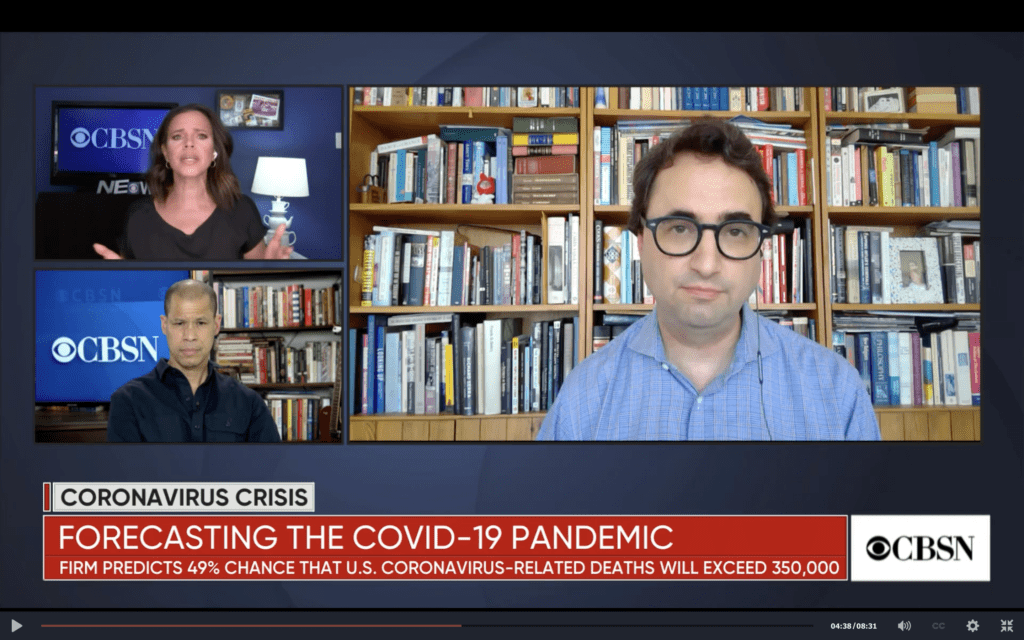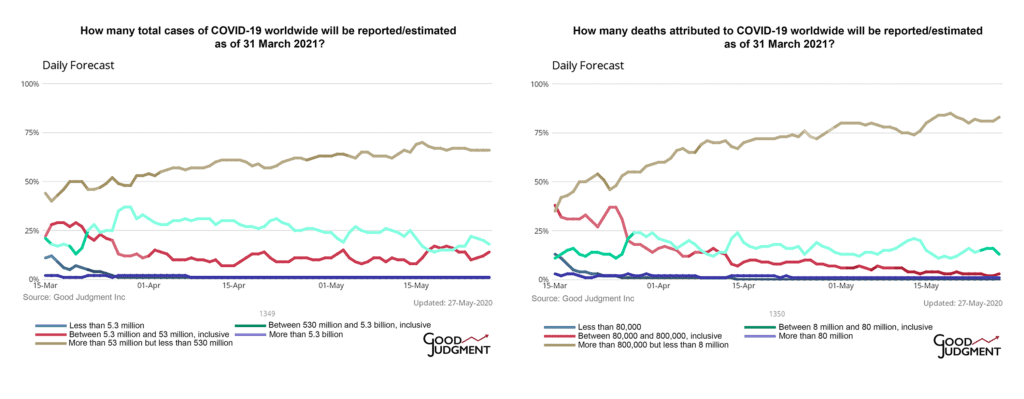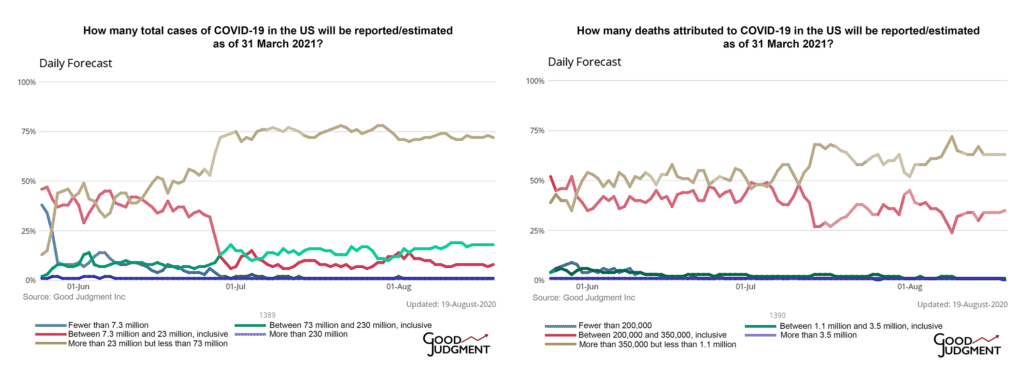More than two million people are dead worldwide, with one-fourth of them in the United States. Such are the grim milestones the world has reached in its struggle with COVID-19.
These numbers came as little surprise to professional Superforecasters, who have been making accurate forecasts on these topics up to a year in advance.
“Unprecedented”
The world surpassed two million deaths attributed to COVID-19 on 15 January 2021. The US death toll reached 500,000 people on 22 February.

A year ago, in March 2020, the unfolding crisis was marked by extreme uncertainty and was widely described as “unprecedented.” Yet, Superforecasters have been assigning the highest probabilities to correct outcomes for worldwide cases and deaths since March 2020, and for US cases and death toll since June 2020.
As the pandemic progressed, Good Judgment forecasts proved “eerily accurate,” as Time magazine put it. “We’re on track to hit two million in reported deaths worldwide if things remain as they are,” one Superforecaster wrote on 26 August. “Add in seasonality, and things will get worse.”
And that’s exactly what happened, as we now know, almost five months after that forecast was made.
“Unless the pace starts to slacken dramatically, all signs point to around 525,000 or thereabouts before the end of March,” another Superforecaster wrote on the US death toll question in January 2021.

Forecasting Emotionally Difficult Questions
Of course, the fact that the COVID-19 numbers did not come as a surprise to Superforecasters as a group hardly makes working on such questions any easier.
“Forecasting deaths is difficult emotionally,” one of Good Judgment’s top Superforecasters, Kjirste Morrell, shared in an interview last month. “Rationally, I know my forecast has no effect on the number of deaths, but I still feel bad, slightly guilty, saying how many people I think will die.”

For emotionally difficult questions, less adept forecasters frequently fall into a cognitive trap called the “social desirability bias.”
In short, the social desirability bias is a cognitive defense mechanism that, when faced with emotionally painful questions, downplays the negatives—from under-reporting less favorable behavior in surveys to underestimating the extent of catastrophic events in forecasting.
The implications could be vast: from invalidating research findings to underestimating the urgency or extent of required response to major events, such as pandemics, conflicts, or migration crises.
Professional Superforecasters are trained to recognize cognitive biases early and mitigate them through multiple effective strategies.
“Earth as an Ant Farm”
Ryan Adler, one of Good Judgment’s Directors and a Superforecaster himself, has described his strategy when forecasting on emotionally wrenching topics: “I try to think of Earth as an ant farm, with me on the outside looking in. From that perspective, it’s easier to forecast solely on what I think will happen, being influenced as little as possible by what I may hope will happen. India car sales is not a brutal topic. Boko Haram’s reign of terror in West Africa, however, is.”
Marc Koehler, Good Judgment’s Senior Vice President and also a Superforecaster, teaches a similar strategy in workshops the company offers to decision-makers in government, finance, and education institutions: “I try to adopt the point of view of a Martian anthropologist, examining homo sapiens through my telescope.”
“The most difficult part of being a professional Superforecaster is not confusing your preferred outcome with the most likely outcome,” says Jean-Pierre Beugoms, another leading Good Judgment Superforecaster interviewed last month. “The task of leaving out one’s biases is even harder when the most likely outcome is a looming disaster. When that happens, I approach the forecast with the following mindset: Forewarned is forearmed.”
To keep cognitive biases in check, Beugoms writes in advance a list of factors that could make him change his predictions.
“Failing to anticipate disasters has done society much harm.”
Superforecaster Jean-Pierre Beugoms
“I also try to approach these unpleasant questions with a sense of mission,” he adds. “Failing to anticipate disasters has done society much harm. An influential Superforecaster, with a record of correctly predicting disasters while avoiding false alarms, may well help society avoid future disasters or, if this proves impossible, can help it prepare for the recovery.”
Morrell has a similar view: “I remind myself that grim forecasts might result in a different course of action being taken. I can hope that changed conditions will make my forecast incorrect.”
What’s next for the world in the struggle against the COVID-19 pandemic? We continue to forecast the number of cases and deaths from COVID-19 and the rollout of vaccinations worldwide. We have delivered accurate forecasts about the timing of vaccine distribution around the world. Newer questions ask about herd immunity in the US and globally as well as how the new normal will look for “work from home” trends, office vacancy rates, and airport capacity. See the latest from Superforecasters through our exclusive all-access monitor, FutureFirst™.
Early Views on the Pandemic
Officials and Media
CDC Director Robert Redfield, 30 January 2020: “We still believe the immediate risk to the American public is low.”
New Scientist, 11 February 2020: “Could the new coronavirus really kill 50 million people worldwide? […] The short answer is that no one knows.”
USA Today, 17 February 2020: “Fauci doesn’t want people to worry about coronavirus, the danger of which is ‘just minuscule.’”
The Atlantic, 26 March 2020: “Are we winning the war against COVID-19? In the fog of pandemic, we simply don’t know.”
President Donald Trump, 27 March 2020: “I’m not sure anybody even knows what it is.”
Scientific American, 1 June 2020: “This coronavirus is unprecedented in the combination of its easy transmissibility, a range of symptoms going from none at all to deadly, and the extent that it has disrupted the world.”
Superforecasters
Cheddar, 28 May 2020: “92 Percent Chance of U.S. Deaths Exceeding 200,000, Superforecaster Says”
Time, 11 June 2020: “’Superforecasters’ Are Making Eerily Accurate Predictions about COVID-19. Our Leaders Could Learn from Their Approach”
CBS News, 22 June 2020: “Forecasting the COVID-19 Pandemic: Firm Predicts 49% Chance that US Coronavirus-Related Deaths Will Exceed 350,000”
Forbes, 13 August 2020: “Superforecasters Predict Vaccine Next Year, Key to the Economic Forecast”
New Statesman, 20 October 2020: “The ‘Superforecasters’ at Good Judgment [Inc] – an American firm that produces impressively accurate predictions of world affairs – put the chances of an approved vaccine being widely available in the US before April 2021 as high as 70 per cent.”
Schedule a consultation to learn how our FutureFirst monitoring tool, custom Superforecasts, and training services can help your organization make better decisions.